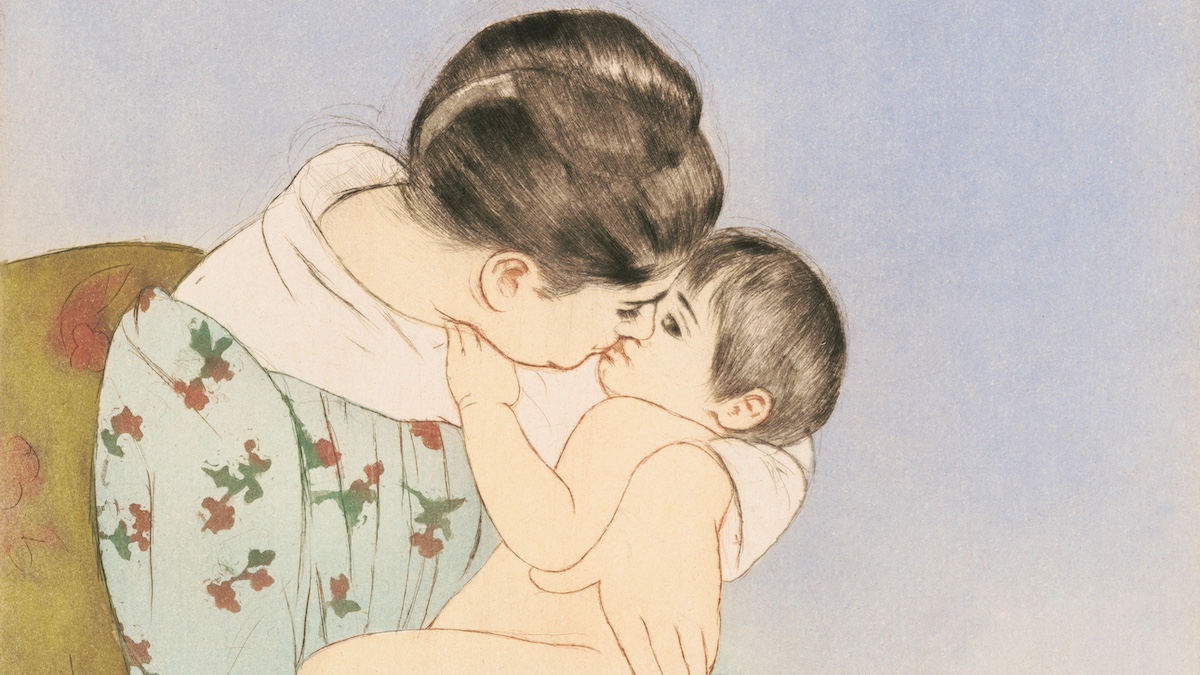Toni Morrison rejected the premise behind the title of Ralph Ellison’s novel Invisible Man. “Invisible to whom?” She asked. “Not to me.” While the white audience may have missed the black presence for too long, the black writer was always aware. Morrison brings that presence forward in her work.
In The Mother Artist: Portraits of Ambition, Limitation, and Creativity, Catherine Ricketts draws on Morrison’s example to spotlight other seemingly invisible figures. Whereas the male-saturated art world had long missed the women working in the shadows, Ricketts grants these mother artists their visibility. Before you open Ricketts’ book, you may not be able to name more than a handful of women artists—even less who are mothers—but after you finish reading, you will have a chorus of women from whom to hear and to whose work you should attend and attend well.
Ricketts features portraits of mother artists, including writers, often pairing those who work in imagistic mediums with those who handle words. She skates through their work and art with ease, linking them together until this disparate group of women appear as a congregation before you, not quite on a pedestal, but uplifted on stage before your eyes. Of course, Morrison is included, but also Carmen Winant, Senga Nengudi, Anito Gavino, Joan Didion, Mickayel Thurin, and too many more to name them all here. Most chapters pair a modern mother artist with a contemporary one (usually one living in Philadelphia in the 2020s). Some are as famous as Morrison—Marilynne Robinson or Madeleine L’Engle, for instance—while others are not the household names that they should be.
As the acclaimed poet Dana Gioia said at a Stanford University Commencement address in 2007, “We live in a culture that barely acknowledges and rarely celebrates the arts or artists.” Most Americans can name more NBA players than artists. Ricketts’ book is a welcome antidote, being countercultural in more ways than one.
An Intimate Conversation
Picking up the book, I did not expect the conversation to be so intimate. But the author has zoomed in on the body of mothers to uplift the uniqueness offered via their embodiment. Her probing question: how does making human life in the ways that mothers do affect their creative making as artists?
Ricketts walks the reader through conception, pregnancy, nursing, and the other physical experiences of mothering, considering how the mother’s body has been understood in relationship to art. “In the history of art, we’re flooded with images that idealize the human figure,” Ricketts writes. We only need to think of Michelangelo’s David or the Venus de Milo statue to register her point. Rarely do we see mom bods. This book explores the mothering body closely (sometimes too close for my taste) and shares images from artists’ work that narrows in and blows up those images for effect.
Ricketts rightly observes that women share birth stories the way that men tell war stories. “No language can quite convey the sensory cataclysm that is childbirth, but poetry might be the best tool we have for it. After all, how does any woman remember those bewildering hours but slant?” Yet until reading novelists such as Morrison, or until the birth of my children, I had never encountered a birth either literarily or live. Considering that birth is an experience shared by every human being, how could we have ignored it in our art and literature for so long?
The answer, of course, is that most men were not present at births and no man has ever physically given birth. Since men have dominated the art and literary world for centuries, readers and observers missed out on poignant expressions of this reality.
Working as a Mother—and an Artist
What else does the mothering life show about the human experience? Ricketts dives deep into the experience of working as a mother—what is lost, what is gained, what is possible. As she has her first baby and attempts to continue working at the Philadelphia Art Museum, Ricketts asks the question that has burdened many women in a similar position, “How do women do this?”
For me, now almost a dozen years into a life with four children and a full-time job, I have almost forgotten the how, because working as a mom is the only life that I know. Ricketts’ portraits of other women remind me of the heartache I that I too have experienced: both from missed opportunities in my work and missed moments at home cradling my little ones. Yet she also gives us so many models of mothers who are creatives. Whereas I would regularly lament, as a new mom, that I had too few examples for how to be a mother and writer, Ricketts’ book fills that void. She shares these women’s lives and their wisdom. “Be OK with your journey,” La Toya Hobbs tells Ricketts, “and give yourself a little time and grace.” These are words that every new mother needs to hear repeatedly, especially those who are also desiring to make beautiful things.
Just as Morrison wrote with black readers in mind, Ricketts writes particularly for the mother artists. She wants these portraits to be an inspiration for those women suffering the fatigue of pregnancy who worry they will never create art again—for those women who are playing pattycake on repeat and wondering if they will ever get to sing a new song. “As we live our lives—especially life’s most intense seasons of longing and joy, tedium and intimacy,” Ricketts writes, “we are folding material into our pockets that will one day unfold as artistic expression.” Fear not, Ricketts repeats in various ways, you will be able to be both mothers and artists.
Although Ricketts encourages her readers to devote time to mothering and to pursue making art, she acknowledges the difficulty of both vocations. “Motherhood is so ordinary that we have trouble seeing all that is extraordinary about it…. When I pause to reflect on the magnitude of the role, I wonder how it can coexist with the ambition that animates professional artists,” Ricketts notes. If one is to be an amazing mother, will that calling supersede all other demands on one’s energy and time? Must mothers choose between being with our babies or serving our art? Ricketts asks, “What are we missing with our backs turned to face our work? Might ambition for our art eclipse our wonderment over our children’s lives?” How can mothers lay on their pillows at night running through the shopping list, schedule of sports and drama, carpool coordinating, etc. and still have brain space to mull over beautiful sentences, compose verses, or imagine murals? Ricketts admits, “Ambition is exciting, but it’s also exhausting.” The balancing act, the tug of war between mothering and creating, the tension is all real, and it is draining.
Letting Many Perspectives Shine
My only pushback would be on the chapter discussing motherhood and desire. In this chapter, Ricketts wrote about Joan Semmel, the nonagenarian who paints nudes of herself looking down. In the 1970s, Semmel’s work was too scandalous to even be shown in New York; the only outlets wanting her work were Penthouse and Playboy.
While sexuality is a significant part of human experience, I am frustrated with the societal compulsion for women to be seductive into their ‘90s. Putting an octogenarian on the cover of Sports Illustrated’s swimsuit edition is not a win. There are a dozen movies and television shows that depict elderly women or widowed mothers rediscovering their sexuality, as though that is what fulfills them. To prioritize sexuality as central for a mother’s creative life seems too easy, too unsurprising, too passé. Rickett’s chapter on this subject would have been improved by adding an alternative perspective to the raging cultural narrative.
Thankfully, through most of the book, Ricketts does consider a variety of perspectives, approaching the subject of mothering and art with a posture of humility. She asks many questions while remaining open to multiple answers. She shows various mothers bringing their children to work, creating sculptures with half a dozen children running around them. She never denigrates motherhood as secondary to art, nor does she uplift the vocation of mothering as above the work. Through the multiplicity of voices, we hear the freedom to be both mothers and artists in various seasons or simultaneously.
Ricketts thus models the “shine theory” that she expounds upon in her book. “Shine theory favors collaboration over competition and embrace over envy,” Ricketts explains. Rather than fighting for a place in the limelight, women shine brighter by passing the light to one another. The Mother Artist becomes an example of how to share the light and thus increase the light.
A Gift—and An Invitation
In the hands of another writer, a book like The Mother Artist could have been a vehement manifesto, a call to arms, or a feminist attack on men. Instead, the book is a gift, an offering. It reads like open hands, like an invitation to join these fellow pilgrims, to make friends with the women sitting in the corners and pull them to the podium. “The more mothers persevere in making art, the more we draw out the best in one another,” Ricketts writes in closing, “thus inviting our audiences to imagine and work for a world humanized by the love of a mother for herself, her family, and her communities.”
Ricketts has a grand ambition for what mother artists offer. Through The Mother Artist, she not only shows us how to imagine such a world but also encourages us to hope for it.



